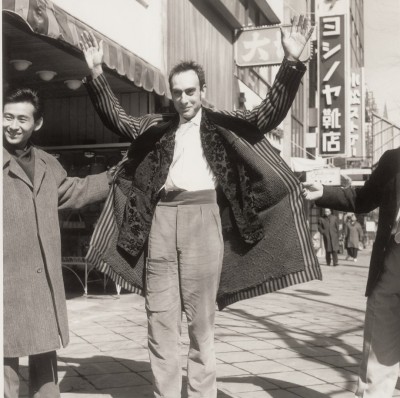Hundertwasser moves! - A review
28. September 2021

Japan, 1961 photo: Keisuke Kojima
That was the title of the campaign weekend by the KunstHausWien and Wien Energie. The occasion for these event days from October 1st to 3rd were the 30th anniversary of the Museum Hundertwasser - KunstHausWien and the 50th anniversary of the Spittelau district heating, which was redesigned by Hundertwasser after a fire in 1987. The program included, among other things, lectures by the climate economist Gernot Wagner and Prof. Bernd Lötsch, as well as the Viennese (climate) complaints choir, a walking gallery in the public space, lightning tours in the museum and tours from the KunstHausWien and Fernwärme Spittelau starting with Austria Guides for Future with ecology Subjects.
Hundertwasser presented art in public space as early as 1961 on his stroll in Tokyo. He assuming various poses for photographs, some of them on the Ginza. This action was meant as a plea for individuality and personal creativity.
In the diary from 1968 Hundertwasser reports on his walk with an original artwork on Stephansplatz in Vienna, which the photographer Stefan Moses documented.

Tokyo stroll
The Belvedere curator Axel Köhne writes in his contribution “Hundertwasser - Performative as cultural criticism” (2013): “Some of the photos show Hundertwasser on the street once again (the famous Ginza, for example), clearly engaged in performances. The motif of the line was once again decisive: Hundertwasser appears to be tracing an imaginary line through the city – one that is potentially endless. He is wearing clothes of this own design (velvet vest and striped coat), his coat, simply carried, is the seeming focus. The artist walks along the busy shopping street, the paving stones with the straight diagonal lines of their joints is clearly visible. He leans against a pillar on which traffic signs with linear motifs are mounted (including one forbidding U-turns). The degree and deliberate manner in which Hundertwasser was capable of stage-managing himself becomes abundantly clear: he crouches atop a fuse box on the side of the street and assumes the pose of a thinker or an artist; he spread out his coat, kneels down on the sidewalk, engages curious passersby who hold up his coat and in doing so bend its straight stripes, he raises his hands above his head as though under arrest. The photos picture a tidy street, everything appears to be orderly; Hundertwasser appears to be the only emphatically unassimilated foreigner, a disruptive factor in the sanitized public space. He is particularly obvious in one such street scene as he holds one of his paintings, Die erste Japan Spirale (The First Japan Spiral) from 1961, high up above the crowd for the camera.
Just six years later that Daniel Buren had two people carry his stiped pictures through the streets of Paris.”